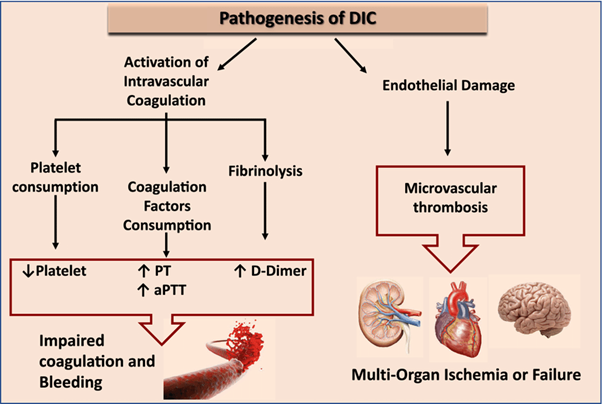Patients in shock receive fresh frozen plasma to replace which one of the following?
Red blood cells
Clotting factors
Platelets
White blood cells
The Correct Answer is B
Fresh frozen plasma (FFP) is a blood product that contains various clotting factors, including factors II, V, VII, VIII, IX, X, XI, and XIII. These clotting factors are essential for the normal coagulation process. In patients with shock, coagulation abnormalities can occur, and administration of FFP can help replenish the deficient clotting factors and restore proper coagulation function.
The other options mentioned are not the primary components replaced by fresh frozen plasma:
A. Red blood cells are in (option A) is incorrect because Red blood cells carry oxygen and are typically replaced by packed red blood cell transfusions in cases of significant blood loss or anemia. Fresh frozen plasma does not contain a significant amount of red blood cells.
C. Platelets in (option C) is incorrect because: Platelets play a role in blood clotting and are typically replaced by platelet transfusions in cases of thrombocytopenia or platelet dysfunction. Fresh frozen plasma may contain a small number of platelets but is not the primary source for platelet replacement.
D. White blood cells in (option D) is incorrect because White blood cells are part of the immune system and are not typically replaced using fresh frozen plasma. Fresh frozen plasma does not contain a significant amount of white blood cells.
Therefore, fresh frozen plasma is primarily administered to patients in shock to replace clotting factors and help restore proper coagulation function.
Nursing Test Bank
Naxlex Comprehensive Predictor Exams
Related Questions
Correct Answer is B
Explanation
Disseminated Intravascular Coagulation (DIC) is a condition characterized by widespread activation of the coagulation system, leading to both excessive clot formation and consumption of clotting factors and platelets. This process can result in both bleeding and thrombosis.
The manifestations mentioned in option B are commonly seen in DIC:
Decreased platelet counts: DIC leads to platelet consumption and destruction, resulting in low platelet counts (thrombocytopenia).
Increased D-dimer: D-dimer is a fibrin degradation product, and its levels are increased DIC due to the breakdown of fibrin clots.
Increased prothrombin time (PT): DIC can lead to the depletion of clotting factors, resulting in prolonged prothrombin time, indicating impaired coagulation.
The other options mentioned do not represent the typical clinical manifestations of DIC:
A. Decreased hematocrit, increased platelet counts, and increased D-dimer in (option A) are incorrect because While platelet counts and D-dimer are increased in DIC, decreased hematocrit is not a characteristic finding.
C. Decreased Antithrombin III, increased platelet counts, and increased fibrinogen in (option C) is incorrect because: Decreased Antithrombin III can be seen in DIC, but increased platelet counts and fibrinogen levels are not specific to DIC.
D. Decreased D-dimer, increased platelet counts, and increased hemoglobin in (option D) is incorrect because Decreased D-dimer and increased hemoglobin are not typical findings in DIC, while increased platelet counts can be seen in some cases.

Correct Answer is B
Explanation
In this scenario, the patient's signs and symptoms suggest a state of shock, which can be caused by various factors, such as hypovolemia, cardiac dysfunction, or systemic vasodilation. The first priority in managing a patient in shock is to ensure adequate oxygenation and tissue perfusion. Administering oxygen at 100% per non-rebreather mask helps improve oxygen delivery to the tissues and supports vital organ function.
A. Placing the patient on a continuous cardiac monitor in (option A) is incorrect because it is an important step to monitor the patient's heart rhythm and identify any abnormalities. However, providing oxygen should take priority to address the potential hypoxemia and tissue hypoperfusion.
C. Inserting two 14-gauge IV catheters in (option C) is incorrect because it is crucial for establishing large-bore access for fluid resuscitation and medication administration. While it is an important step, addressing oxygenation takes precedence.
D. Drawing blood to type and crossmatch for transfusions in (option D) is incorrect because it is an important step in managing a patient in shock who may require blood products. However, ensuring adequate oxygenation through oxygen administration is the immediate priority.
Therefore, the nurse should act first on the order to administer oxygen at 100% per non-rebreather mask to support the patient's oxygenation and tissue perfusion.
Whether you are a student looking to ace your exams or a practicing nurse seeking to enhance your expertise , our nursing education contents will empower you with the confidence and competence to make a difference in the lives of patients and become a respected leader in the healthcare field.
Visit Naxlex, invest in your future and unlock endless possibilities with our unparalleled nursing education contents today
Report Wrong Answer on the Current Question
Do you disagree with the answer? If yes, what is your expected answer? Explain.
Kindly be descriptive with the issue you are facing.
